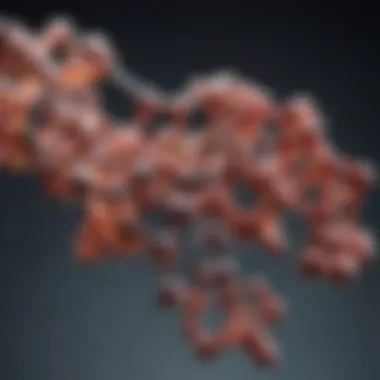Understanding Histidine: Functions and Applications


Intro
Histidine is a paramount amino acid found in many proteins. This compound is critical for various biochemical processes in the body. It is not only essential for protein synthesis but also plays a significant role in enzyme activity, pH buffering, and the production of vital molecules. Unlike some amino acids, histidine is considered semi-essential. This means that while the body can synthesize some histidine, it often needs additional sources from the diet.
In this article, we will explore several facets related to histidine. We will begin by covering the fundamental structural characteristics of this amino acid, then proceed to its biochemical functions and implications in nutrition and medicine. The latter part of the article will highlight its metabolic pathways and therapeutic applications. Our aim is to provide a clear understanding of histidine that will be useful for students, researchers, educators, and professionals in the field.
Research Overview
Summary of Key Findings
Histidine has several critical functions. Some of the key findings include:
- It acts as a precursor to histamine, a neurotransmitter involved in immune responses and regulating physiological functions.
- It participates in the synthesis of hemoglobin, which carries oxygen in the blood.
- It supports the maintenance of the body's acid-base balance through its buffering actions.
These points illustrate its significance in various biological contexts, reaffirming histidine's essential role.
Background and Context
The understanding of histidine dates back to the early studies on amino acids. Initially identified as a part of protein structures, researchers have gradually uncovered its broader implications in nutrition and healthcare. Histidine-rich foods include meat, poultry, fish, dairy products, and certain grains. The availability of histidine from these dietary sources demonstrates its importance in a balanced diet, especially during periods of growth and recovery from illness.
Methodology
Experimental Design
To grasp histidine's roles fully, research often employs both in vitro and in vivo methods. These studies may analyze histidine's effects quantitatively and qualitatively across different biological systems.
Data Collection Techniques
Data collection varies but often includes:
- Spectrometric analysis to measure histidine concentrations
- Enzymatic assays for observing biological activities
- Dietary surveys to assess histidine intake
Through these techniques, a comprehensive understanding of histidine's biochemical properties and its effects on health can be constructed.
"Histidine is one of the building blocks of life; its contributions span from cellular function to overall well-being." - A scientific review on amino acids.
By exploring these components, we not only recognize histidine's critical physiological roles but also understand its potential in therapeutic scenarios.
Prelude to Histidine
Histidine is an amino acid that plays a vital role in many biological processes. This section introduces histidine, emphasizing its significance in both physiological and biochemical contexts. Understanding histidine encompasses various aspects, from its basic structure to its intricate involvement in protein synthesis and other essential functions.
One important aspect of histidine is its classification as a semi-essential amino acid. This means that while the body can produce histidine, dietary sources become necessary under certain conditions, like stress or injury. Such duality highlights the need to explore both its biological production and external sources.
Histidine is particularly notable for its role in the active sites of various enzymes. It significantly contributes to both the structure and function of proteins. Furthermore, histidine's unique properties make it an effective buffer. This buffering capacity is crucial in maintaining the pH balance within the blood and other bodily fluids.
The implications of histidine extend beyond basic biological functions. In human health, histidine participates in the production of histamine, a compound important for immune responses and digestive functions. Moreover, its presence in the body can influence neurological functions, showcasing its multifaceted nature.
In essence, this section sets the stage for an in-depth exploration of histidine. Readers can expect to gain insights into its structure, physiological relevance, and broader health implications. The knowledge of histidine is not just academic; it has practical applications in nutrition and therapeutic fields. Thus, establishing a robust understanding of histidine is essential for anyone involved in biological sciences, nutritional studies, or healthcare.
Definition and Chemical Structure
Histidine is an alpha-amino acid that plays a crucial role in various biological functions. Understanding its definition and chemical structure is essential for grasping the broader implications of histidine in physiological and biochemical contexts. Its distinctive attributes greatly influence its usability in both nutrition and health.
Molecular Composition
Histidine has a unique molecular composition which distinguishes it from other amino acids. The chemical formula for histidine is C6H9N3O2. This structural framework includes a central carbon atom associated with an amino group (-N), a carboxyl group (-COOH), and a unique imidazole side chain. The imidazole side chain is particularly notable because it can exist in both charged and uncharged forms depending on the pH of the surrounding environment.
The side chain contributes to histidine's ability to participate in enzyme-catalyzed reactions and to function as a buffering agent in physiological conditions. Its role in stabilizing protein structures and facilitating enzyme activity cannot be overlooked. This molecular makeup supports various functions, including involvement in metabolic pathways vital for cellular function.


Isomeric Forms
Histidine contains several isomeric forms, which can further affect its usability in biochemistry. The two primary isomers are L-histidine and D-histidine. L-histidine is the biologically active form found in proteins and is more commonly studied in the context of human biology. In contrast, D-histidine has limited roles in nature and is not typically found in proteins.
The ability to exist as different isomers means that the interactions of histidine with other molecules can vary. For example, L-histidine engages in physiological functions, whereas the role of D-histidine remains less clear. Understanding these distinctions is critical for researchers focusing on histidine's potential therapeutic applications and its role in nutrition.
Histidine's molecular structure allows it to act as a versatile player in biological processes, influencing enzyme activity and pH balance.
In summary, a thorough understanding of histidine's definition and chemical structure lays the groundwork for exploring its multifaceted roles in biology and nutrition. As research evolves, these foundational concepts remain pivotal in appreciating histidine's relevance both in academic discourse and practical applications.
Physiological Role of Histidine
Histidine serves multiple critical roles in the human body. Its physiological importance is broad, influencing various biochemical pathways and systems. This amino acid is not only vital for protein synthesis but also plays significant roles in enzyme activity and maintaining acid-base balance in blood. Each of these functions contributes to overall health, underlining the necessity of adequate histidine in the diet.
Role in Protein Synthesis
Histidine is one of the twenty standard amino acids used by cells to synthesize proteins. As a precursor in the formation of histidine-rich proteins, it features prominently in connective tissues and muscle proteins. The presence of histidine is essential in the formation of hemoglobin, the protein molecule in red blood cells that carries oxygen throughout the body.
Additionally, histidine helps form enzymes crucial for metabolic processes. Proteins containing histidine often act as buffers to help maintain pH levels within cells. This buffering ability is particularly pertinent during metabolic changes, where acid-base balance can swing. Without sufficient histidine, these functional protein assemblies may suffer hindered synthesis, consequentially affecting tissue repair and growth.
Involvement in Enzyme Activity
Histidine plays a pivotal role in enzyme functionality. Many enzymes rely on histidine residues at their active sites for catalysis. The ionizable side chain of histidine allows it to donate and accept protons, making it an effective participant in enzyme-substrate interactions. For instance, in the process of catalysis, histidine often facilitates proton transfer, crucial in many biochemical reactions.
One notable example lies within the enzyme urease. Histidine’s side chain assists in the hydrolysis of urea, demonstrating its role in metabolic processes. Moreover, due to its unique properties, histidine aids in stabilizing proteins and enzymes, impacting overall enzymatic efficiency. Such insights reveal just how integral histidine is to maintaining proper metabolic functions.
Buffering Capacity in Blood
The buffering capacity of histidine in blood cannot be overstated. Histidine is a part of the physiological buffer systems that includes bicarbonate and proteins, which help maintain blood pH. It has a notable imidazole side chain that can accept or donate protons depending on the surrounding pH levels.
In conditions where blood acidity increases, histidine can help counteract this change, thus ensuring that the pH remains within the narrow range needed for physiological function. This buffer action prevents acidosis, which can lead to severe metabolic disturbances. In summary, histidine’s buffering ability is essential for homeostasis, showcasing another layer of its physiological significance.
Biochemical Pathways Involving Histidine
Histidine plays a critical role in various biochemical pathways that are fundamental to cellular functioning and overall metabolism. Understanding these pathways is essential for appreciating how histidine contributes to biological processes. The two primary pathways involving histidine are its synthesis and catabolism, as well as its conversion to histamine.
Synthesis and Catabolism
Histidine is classified as an essential amino acid, meaning that it must be consumed through the diet. However, it can also be synthesized in smaller amounts in the body. The de novo synthesis of histidine involves several steps, beginning from simple metabolites. One of the key precursors is phosphoribosyl pyrophosphate (PRPP), which plays a significant role in several biosynthetic pathways.
In the catabolism of histidine, it is broken down into several different molecules, including alpha-ketoglutarate and other intermediates. This process occurs primarily in the liver and can involve transamination processes. One important outcome of histidine catabolism is the production of urocanic acid, which has implications for skin health and photosensitivity.
The importance of these pathways extends beyond simple metabolic processes. They underline how histidine not only serves as a building block for proteins but also supports various physiological functions. Proper synthesis and catabolism of histidine ensure that the body maintains a healthy balance of this amino acid, which is crucial for many bodily functions.
Conversion to Histamine
Histidine is a precursor for histamine, a biogenic amine that plays diverse roles in the body, particularly in immune responses and neurotransmission. The conversion of histidine to histamine occurs through a decarboxylation reaction, catalyzed by the enzyme histidine decarboxylase.
Histamine is best known for its actions in the immune system, where it is released during allergic reactions. It contributes to inflammation, vasodilation, and the regulation of gastric acid secretion. The neurotransmitter function of histamine is also vital, as it influences wakefulness, appetite regulation, and cognitive functions.
This conversion not only highlights the importance of histidine itself but also illustrates its broader significance in various physiological responses. Understanding these pathways helps to highlight the interconnectedness of metabolic processes and their relation to health and disease.
"Histidine serves both as a building block for proteins and as a precursor for important biological molecules, illustrating its multifaceted role in biochemistry."
In summary, the biochemical pathways involving histidine—its synthesis, catabolism, and conversion to histamine—underscore its essential functions in maintaining health. These processes are fundamental for the understanding of amino acid metabolism, illustrating how histidine contributes to various biological systems in the body.
Histidine in Nutrition
Histidine is an amino acid that plays a vital role in human nutrition. Understanding its significance aids in recognizing how it supports various bodily functions. This section discusses dietary sources, recommended allowances, and the consequences of deficiency. By comprehending histidine's nutritional value, one can gain insight into maintaining optimal health.


Dietary Sources of Histidine
Histidine is found in various food products. It is essential for the diet as the body cannot produce it in sufficient amounts. Some common sources of histidine include:
- Meat: Beef, chicken, and turkey are rich in histidine and offer significant protein content.
- Fish: Species like tuna and salmon provide ample histidine, alongside omega-3 fatty acids.
- Dairy Products: Milk, yogurt, and cheese contain histidine, making them good choices for those seeking to increase their intake.
- Eggs: Eggs not only provide high-quality protein but are also a good source of histidine.
- Legumes: Beans, lentils, and chickpeas contribute plant-based histidine, which is beneficial for vegetarians.
Incorporating these foods into daily meals ensures adequate histidine intake, supporting overall health.
Recommended Dietary Allowances
Determining the right amount of histidine needed is essential. The recommended dietary allowances can vary based on age, sex, and life stage. However, general guidelines suggest:
- Infants: 10 mg/kg body weight per day
- Children: 8-10 mg/kg body weight per day
- Adults: 7 mg/kg body weight per day
It is also important for pregnant or nursing women to ensure adequate intake, as histidine contributes to fetal and infant development. Calculating personal histidine needs according to body weight can help in fulfilling nutritional requirements.
Effects of Deficiency
Histidine deficiency is relatively rare, given its presence in available food sources. However, it can occur under certain conditions, leading to various health complications. Some noted effects of histidine deficiency include:
- Impaired Immune Function: Low histidine levels can hinder the immune response, making the body more susceptible to infections.
- Anemia: Histidine is crucial for hemoglobin production. A deficiency may result in anemia, characterized by decreased red blood cells.
- Mental Fatigue: Histidine has a role in neurotransmitter regulation. Low levels can potentially lead to mood changes or cognitive issues.
Health Implications of Histidine
Histidine, as an amino acid, plays a pivotal role in several health-related functions. Its influence extends beyond just being a basic building block for proteins. In the body, histidine significantly contributes to immune system support, neurotransmission, and offers potential antioxidant effects. Understanding these implications is crucial for comprehending histidine's overall importance in human health, both at a cellular level and through dietary intake.
Influence on Immune Function
Histidine may enhance the immune response. It serves as a precursor for histamine, a critical compound that modulates immune reactions, including allergic responses and gastric acid secretion. Histidine aids in the production of various immune cells. In addition, it supports the proliferation of lymphocytes, which are essential for fighting infections. A study suggests that adequate histidine levels may decrease susceptibility to infections, underscoring its importance during periods of illness.
"Histidine is essential for optimal immune function, linking dietary intake to overall health outcomes."
Role in Neurotransmission
The role of histidine in neurotransmission cannot be overstated. Histidine plays a part in the synthesis of histamine, which is vital for various brain functions, including learning and memory. Histamine also helps regulate sleep, appetite, and attention. Disruptions in histidine levels have been associated with cognitive impairments, indicating its importance in neurological health. Furthermore, histidine's involvement in stabilizing neurotransmitter release adds to its significance in maintaining brain function.
Potential Antioxidant Effects
Histidine displays potential antioxidant properties. This amino acid can scavenge reactive oxygen species, reducing oxidative stress in the body. Oxidative stress contributes to various diseases, including heart disease and cancer. By neutralizing these harmful molecules, histidine may confer protective effects on cells and prevent chronic diseases. Some research suggests that a diet rich in histidine could support overall health by minimizing oxidative damage, although more studies are necessary for conclusive evidence.
In summary, histidine emerges as a multifaceted compound essential for maintaining various bodily functions. Its role in the immune system, neurotransmission, and antioxidant defense illustrates its importance in health and disease management.
Histidine and Disease
Histidine plays a significant role in various disease processes. Understanding its function can provide insights into potential therapeutic strategies. This section will cover the interplay between histidine and diseases, focusing on its implications in cancer, cardiovascular health, and inflammation.
Histidine and Cancer
Cancer remains one of the leading health concerns globally. Research indicates that histidine might have a dual role in cancer biology. It serves not only as a building block for proteins but also as a precursor for histamine synthesis. Elevated levels of histamine can contribute to tumor growth by promoting angiogenesis, which is the formation of new blood vessels that supply nutrients to tumors.
Conversely, some studies suggest that adequate histidine levels may enhance the immune response against tumor cells. The balance of these effects remains a topic of ongoing research. Exploring histidine's involvement could lead to novel strategies for cancer therapies. More studies are needed to clarify its exact role and determine how histidine adjustments might influence cancer outcomes.
Cardiovascular Health
Histidine's impact on cardiovascular health is also noteworthy. It has been shown to participate in the synthesis of carnosine, a compound that acts as an antioxidant. Antioxidants play a crucial role in protecting blood vessels from oxidative stress, which can lead to atherosclerosis—a condition that narrows the arteries.
Moreover, histidine may aid in regulating blood pressure. Some preliminary studies suggest that it could influence the balance of certain hormones that regulate vascular tone. Maintaining appropriate histidine levels may therefore be beneficial in supporting heart health. This highlights the importance of dietary sources of histidine as part of a heart-healthy diet.
Inflammation and Histidine


Inflammation is a natural response by the body to injury or infection. However, chronic inflammation can lead to various health issues, including autoimmune diseases. Histidine plays a role in modulating immune responses. It has the potential to influence the production and activity of immune cells.
In particular, histidine's role in histamine production becomes relevant here. Histamine is involved in inflammatory responses, and an imbalance can contribute to conditions like allergic reactions and chronic inflammatory diseases.
Recent research indicates that proper histidine levels may help balance this response, reducing excessive inflammation and promoting healing. Therefore, understanding histidine's contributions in this context could have implications for treating inflammatory diseases effectively.
"The intricate relationship between histidine and disease processes underscores the need for further research to fully understand its potential at supporting health."
Therapeutic Applications of Histidine
Histidine holds relevance beyond its basic physiological roles. Its therapeutic applications are becoming more recognized in nutrition and clinical contexts. Understanding these applications contributes to a comprehensive view of this amino acid and its potential benefits.
Histidine in Supplementation
Supplementation of histidine can be beneficial under various circumstances. Athletes, for instance, may consider histidine supplements to support muscle recovery and improve performance. It has been noted that histidine can enhance the metabolism of certain nutrients necessary for energy. Moreover, it assists with the synthesis of carnosine, which helps buffer acid in muscles during high-intensity exercise.
Certain populations may have increased needs for histidine. Older adults, for example, are often at risk for histidine deficiency due to dietary limitations or changes in metabolism. As a result, incorporating histidine into their diets through supplements can help mitigate potential health issues associated with aging.
"Histidine supplementation might aid not only in athletic endeavors but also in supporting overall health in specific demographics."
However, caution is essential when administering histidine supplements. Over-supplementation can lead to imbalances in amino acids and should be monitored. It is crucial to consult healthcare professionals before beginning any supplementation regimen.
Clinical Applications
The clinical applications of histidine present a wide array of possibilities. Its role in the synthesis of histamine, a critical neurotransmitter, highlights its importance in various physiological processes. Conditions such as allergies or gastrointestinal disorders may warrant investigation into histidine's therapeutic role. Some studies suggest that controlling histamine levels can aid in managing allergic reactions or inflammatory responses.
Histidine also shows promise in relation to neurodegenerative diseases. Research indicates that histidine may help protect neurons in the brain from oxidative stress. With the rise of conditions like Alzheimer's disease, further exploration into histidine’s neuroprotective effects could prove significant.
Additionally, there is ongoing research into histidine's impact on cardiovascular health. Some studies propose that histidine supplementation might improve endothelial function, which is crucial for vascular health.
In summary, histidine's therapeutic applications are vast and still under review. With substantial potential in both supplementation and clinical settings, further research could reveal deeper insights into its functionalities and advantages in health management.
Research and Future Directions
Research into histidine is ever-evolving, holding significant promise for numerous fields in biochemistry and medicine. Understanding histidine helps deepen knowledge of its biochemical pathways and implications on health. It can lead to new insights into prevention and treatment of various diseases.
Researchers are currently focused on several aspects. There is an increasing interest in how histidine functions at molecular levels and its roles beyond basic nutritional requirements. For scholars and practitioners in the field, these insights shape future studies and therapeutic approaches.
Current Studies on Histidine
Recent investigations delve into histidine's multifaceted roles. Studies emphasize its importance in metabolic syndromes and neurological health. The connection between histidine and immune responses is particularly noteworthy.
- Metabolic Effects: Researchers are examining how histidine affects insulin sensitivity and glucose metabolism. Studies suggest that adequate histidine levels might enhance overall metabolic health.
- Neurological Research: There is ongoing research on histidine's impact on cognitive functions and neuroprotection. Studies show potential benefits in age-related cognitive decline. Histidine is also observed in neurotransmitter modulation, especially in relation to histamine's synthesis.
- Cancer Research: Some studies explore the involvement of histidine in cancer pathways. Understanding its function could lead to novel cancer treatments.
These studies contribute to a broader understanding of how histidine interacts within biological systems, laying the groundwork for new applications.
Potential for New Therapeutics
The therapeutic potential of histidine is quite expansive. As mentioned previously, histidine is pivotal in various biological processes. Now, researchers are turning attention to harness this for therapeutic uses.
- Pharmaceutical Development: New drugs targeting histidine's metabolic pathways may enhance treatment options for chronic diseases. The modulation of histidine may provide an avenue for designing drugs with fewer side effects.
- Dietary Supplementation: Increased awareness about histidine's optimal levels has led to supplement developments. These interventions are aimed at both enhancing general health and finishing specific medical conditions.
- Functional Foods: As research advances, there is potential for incorporating histidine-rich foods into functional diets tailored towards disease prevention.
Understanding histidine opens a door to new horizons in medicine and nutrition. Research indicates that its applications could revolutionize treatment protocols.
In summary, the future of histidine research is vast and holds substantial promise for improving health outcomes and therapeutic applications. Continued exploration will certainly illuminate histidine's full potential in the realms of health and disease management.
Closure
The conclusion of this article on histidine serves as a summary, reinforcing the importance of this amino acid in various biological and health contexts. Histidine's multifaceted roles in protein synthesis, enzyme activity, and metabolic processes highlight its essential functions within living organisms. Specifically, understanding its impact on nutrition and health can guide dietary choices and supplementation strategies.
Key benefits of incorporating knowledge about histidine include:
- Health Optimization: Awareness of histidine's roles can lead to better health outcomes, particularly regarding immune function and neurotransmission.
- Dietary Considerations: By recognizing food sources rich in histidine, individuals can improve their diet, ensuring that they meet the necessary intake levels.
- Research Advancements: The ongoing research surrounding histidine hints at potentially new therapeutic applications, consolidating its relevance in medical science.
Moreover, the implications of histidine in diseases, particularly cancer, cardiovascular health, and inflammation, underline the complexity of its functions and the potential need for targeted research. This exploratory journey emphasizes that histidine is more than a simple amino acid; it is a pivotal player in maintaining physiological balance and promoting optimal health.
Histidine deserves continued study and application in both clinical and everyday nutrition contexts, solidifying its position as a critical component in health sciences. Thus, the conclusion emphasizes the synthesis of this knowledge and encourages further exploration of histidine's diverse applications. The potential for future research remains vast, paving the way for innovative approaches to health and disease management.







